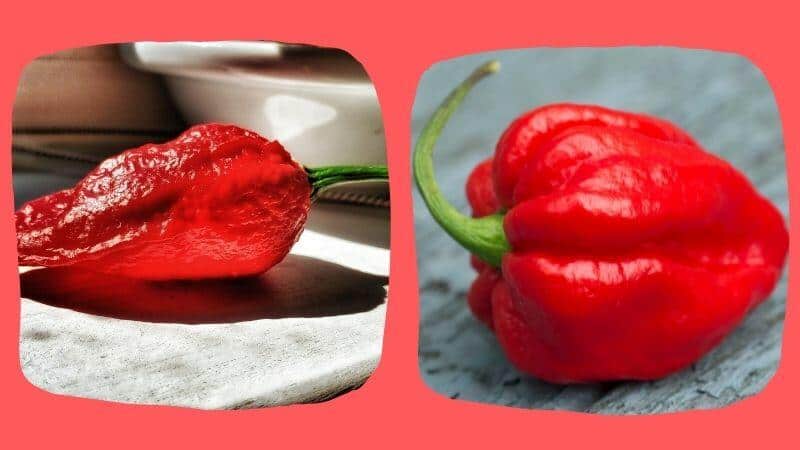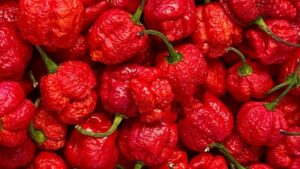The world of hot peppers is scorching hot, with two chili varieties battling for the crown of “world’s hottest.” So how do the legendary Ghost pepper and fiery Carolina Reaper compare when going head to head?
While both pack record-shattering, mouth-burning heat, they each bring a different kind of firepower. Ghost peppers are known for their slow, building burn that steadily increases over minutes. Carolina Reapers provide a faster, more immediately intense blast of heat.
In terms of raw heat, Carolina Reapers take the lead. They average over 2 million Scoville Heat Units (SHUs), more than double the 1 million SHUs of Ghost peppers. That makes Reapers over 400 times hotter than a mild jalapeño!
But when it comes to flavor, Ghost peppers have a distinctive fruity, citrusy taste that builds in layers. Carolina Reapers have a sweeter, tropical fruitiness that quickly gives way to searing heat.
So which is the ultimate “hottest pepper” winner? It depends…
If you value sheer, record-breaking heat intensity, the Carolina Reaper now wears the crown. But for chiliheads who crave a more slow-burning, flavorful heat, the Ghost pepper still reigns supreme.
This in-depth comparison explores everything you need to know about growing, eating, and surviving these killer peppers. Can your tastebuds handle the heat? Let the battle commence!
A Chili Champ Emerges: The Rise of the Ghost Pepper
The Ghost pepper, also known as Bhoot Jolokia, reigned as the world’s hottest pepper for over half a decade. This chili clinched the coveted record back in 2007 with a fiery rating of over 1 million Scoville Heat Units (SHUs).
Native to Northeast India, the Ghost pepper offers a unique fruity, citrusy and slightly smoky flavor profile before unleashing its searing burn. With nearly double the heat of a potent Habanero, it quickly developed a reputation as one formidable fiery pod.
In addition to raw heat, Ghost peppers exhibit an intense slow-building burn that caused many to dub it the “King of Chilies.” The creeping crescendo of heat and distinctive fruity aroma solidified its cult-favorite status among diehard chiliheads.
A New Contender Emerges: Carolina Reaper dethrones Ghost Pepper
Just when the Ghost pepper seemed set as the undisputed champ, a newcontender emerged to challenge the crown. Ed Currie, founder of the PuckerButt Pepper Company, created the now-infamous Carolina Reaper in South Carolina.
After extensive testing, the Reaper averaged an astonishing 1.5 million SHUs, easily surpassing the Ghost pepper’s previous record. But the Reaper didn’t stop there. In 2013, further testing pushed its official Guinness World Record average to over 1.6 million SHUs.
Nearly twice as hot as the Ghost pepper, the Reaper brought record-shattering, scorching heat into the chili limelight. Its introduction set off a heated arms race between chili breeders vying to create the next world’s hottest pepper.
The Great Chili Face-Off: Ghost Pepper vs. Carolina Reaper
Now that these two chili heavyweights have entered the ring, let’s compare their key stats and attributes:
Heat Factor
- Ghost Pepper: 855,000 – 1,041,427 SHU
- Carolina Reaper: 1,400,000 – 2,200,000 SHU
With more than double the SHUs of the Ghost, the Reaper easily packs more raw heat. On the Scoville scale, it’s approximately 400 times hotter than a Jalapeño pepper!
Shape & Appearance
- Ghost Pepper: Long, slender pods around 2.5-3.5 inches long. Thinner skin that wrinkles when mature. Colors range from bright red, orange, yellow, and even chocolate brown.
- Carolina Reaper: Thicker, smaller pods at 2-3 inches long and 1-2 inches wide. Distinctive bumpy texture with a stinger-like tail. Signature red color.
Taste Profile
- Ghost Pepper: Intense fruity flavor with hints of citrus and smoke. Building, lingering burn.
- Carolina Reaper: Bright fruity taste gives way to an exceptionally fast and fierce heat.
Both offer great fruity flavor to accompany their sky-high heat levels.
Origin
- Ghost Pepper: Native to Northeast India; a naturally occurring Capsicum Chinense variant.
- Carolina Reaper: Created by Ed Currie of South Carolina by crossing the Capsicum Chinense and a Pakistani Naga pepper.
The Ghost has centuries of natural evolution behind it, while the Reaper is a more “designed” pepper.
Experiencing the Heat: Ghost Pepper vs. Carolina Reaper
Reading Scoville ratings only tells part of the story. Here are some real world experiences taking on these peppers to compare their true heat impacts.
Consuming Ghost Peppers:
- “I took a small bite of a fresh Ghost pepper to try it raw. For the first 30 seconds, I just tasted sweet fruitiness. But then a deep, burning heat rapidly built until my whole mouth was lava. I was sweating, nose running, eyes watering – 10/10 pain.”
- “Eating a smoked Ghost pepper was like putting a lit match on my tongue. It started as a woodsy flavor before erupting into a slow-creeping fire in my mouth that lasted over 30 minutes.”
- “Ghost peppers make your head spin and extinguish all other flavors. All you can focus on is the fiery heat sear of your tongue and throat. It’s as painful as it is addicting for spicy food fans.”
Facing the Carolina Reaper:
- “I ate one tiny piece of a Carolina Reaper and thought I was going to die. After the initial sweetness, my mouth felt like scorched earth. The rapid heat spike was so intense I couldn’t speak or breathe for a minute straight.”
- “It only took 5 seconds before the Reaper set my mouth ablaze with searing, dizzying heat. For 15 agonizing minutes all I could do was sit there sweating, guzzling milk to try and quell the inferno.”
- “Reapers produce a much faster, more intense blast of heat compared to other super hots. An immediate fire that overwhelms your senses, makes your extremities tingle, and brings you to your knees.”
Growing Your Own Hellishly Hot Peppers
Think you have what it takes to grow these Satanically spicy peppers at home? Here are some tips for cultivating your own:
Ghost Pepper Care
- Germination time: ~35 days
- Ideal daytime temps: 75°F
- Soil temperature range: 80-90°F
- Sensitive to overwatering; let soil dry between waterings
- Produces 10-20+ peppers per plant
Carolina Reaper Care
- Germination time: ~21-30 days
- Ideal daytime temps: 70-85°F
- Soil temperature range: 64-68°F
- Drought tolerant; avoid overwatering
- Each plant yields roughly 20-30 peppers
With the right conditions, anyone can harness the heat! But always exercise caution when handling these killer peppers.
Igniting Your Tastebuds: Uses for Hottest Peppers
What’s the best way to experience these peppers and harness their extreme heat? Here are some favorite uses for these scorching-hot chilies:
- Add small amounts of pepper flesh or flakes to spicy sauces, salsas, chili, curry and stir fries.
- Infuse vodka or other spirits with peppers to make scorching-hot tinctures.
- Smoke peppers over wood before drying to make chipotle chili powder.
- Layer super-thin slivers into sandwiches, tacos, eggs or pizza for instant heat.
- Daredevil YouTube stunts and pepper-eating challenges. (Not recommended!)
Think you can handle the heat? Add just a pinch of these peppers at a time to build up your tolerance gradually.
Crowing the Chili Champ: Ghost Pepper or Carolina Reaper?
When it comes to sheer Scoville heat, the Carolina Reaper now firmly holds the hot pepper throne. But legendary Ghost peppers aren’t bowing out of the race just yet.
While the Reaper may pack more raw firepower, the Ghost offers a nostalgic slow-building burn that chiliheads have come to love. At the end of the day, determining the definitive “hottest” pepper comes down to personal preference and individual heat tolerance.
The takeaway? With either of these white-hot peppers, exercise extreme caution. TheirLegendary heat transforms ordinary meals into fiery feats of human strength and bravado. Never underestimate the wrath of a Ghost pepper or Carolina Reaper! Are you fiery foodie enough to take the heat?





